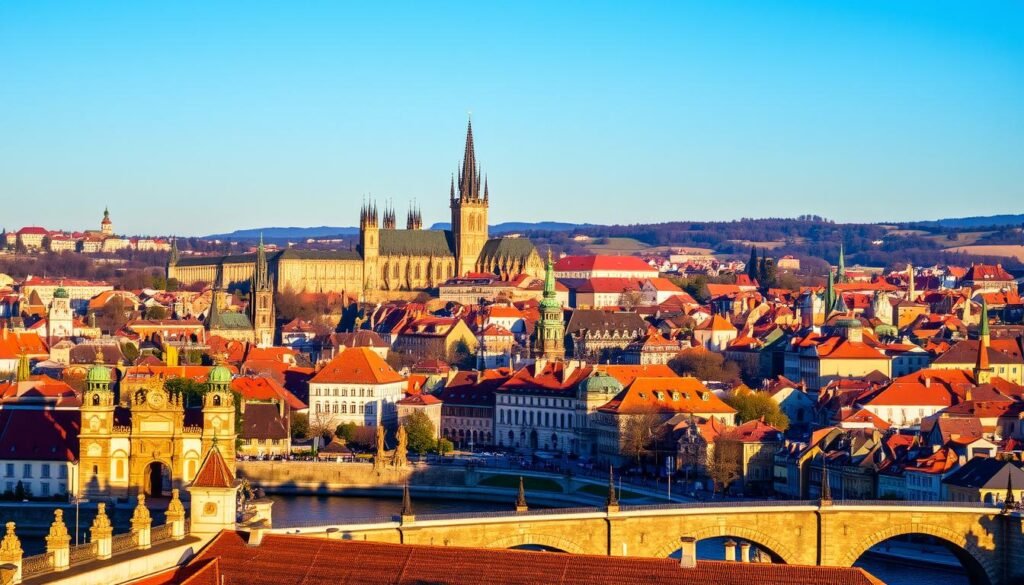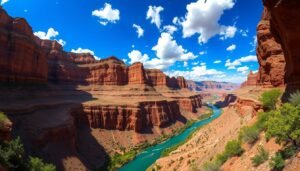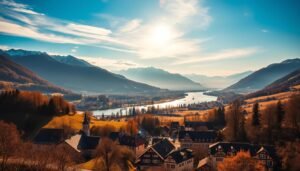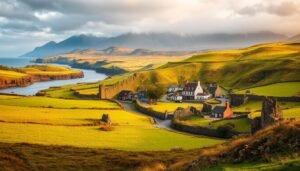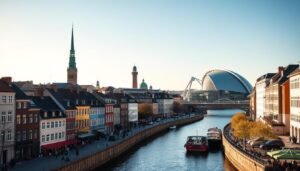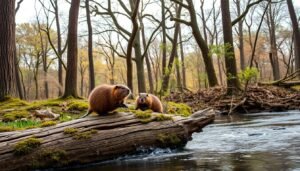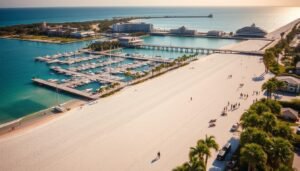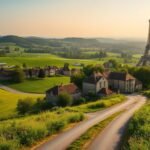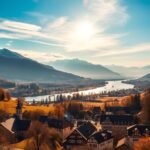Surprising fact: the nickname “The City of a Hundred Spires” came from a 19th-century count who cataloged Prague’s skyline, and much of that Gothic, Baroque, and Renaissance fabric survived World War II.
I plan each trip around a clear list of areas: Old Town, the castle district, and the riverfront. I walk, ride trams, and pace my time so I avoid backtracking between Old Town Square, Charles Bridge, and the castle.
I share when I arrive at the clock show and when I head back for blue-hour photos. I point out where I find the best beer, quick-view towers, and quiet gardens that balance busy squares and landmark buildings.
This post maps top routes and budgets so your visit feels effortless. Read on and you’ll see timed routes, money-saving tips, and the places I think shine most in this compact capital.
Key Takeaways
- Prague’s surviving architecture creates a rich, walkable city core.
- I plan routes that link Old Town Square, the bridge, and the castle.
- Visit early or late for photos and to avoid long lines.
- Sample local beer and quick tower views for the best rooftop scenes.
- This post gives timed routes, budgets, and my favorite spots.
Why I Keep Coming Back to Prague’s Old Town charm

A single walk through Old Town feels like leafing through Prague’s living history book. The square has layers from the 12th century onward, where Gothic spires and Rococo facades sit side by side.
Old Town Square highlights
The old town square holds the Gothic Church of Our Lady before Týn, Baroque St. Nicholas, and Kinský Palace. I point out the spires and the spot I use to frame them for photos.
Old Town Hall Tower views and the story beneath your feet
I climb the Old Town Hall Tower at golden hour for wide city views with fewer people. Markings in the pavement mark the 1621 execution of 27 Czech lords—an honest reminder of past trials.
- I map a short route from this place toward Charles Bridge, naming quiet streets for coffee and quick photos.
- I show where to watch the Astronomical Clock details without getting swept into the crowd.
- When I want context, a brief guided tour helps; otherwise I wander and sample local beer and food.
Astronomical Clock: when to go and what you’re actually seeing

The Orloj’s face has watched this city for over six centuries, and its hourly ritual still draws a crowd. I like to arrive with a clear plan so the moment feels like discovery rather than a scramble.
The astronomical clock was installed in 1410, making it the third-oldest of its kind and the oldest still running. Each hour from 9am to 11pm the twelve apostles parade while bells ring beside a skeleton figure.things-to-do-in-charleston/
The hourly “Walk of the Apostles” explained
I position myself slightly off-center so I can see the moving figures and the full facade at once. Watch the zodiac dial and calendar ring—I explain their meaning on a short tour if you want medieval mechanics decoded.
Tips to beat the crowds and get the best photos
I prefer early morning or late evening for detail shots without a wall of phones. After an hour strikes I usually head up the tower; timing your climb right after the show often skips the longest lines.
| What | Why it helps | My tip |
|---|---|---|
| Position | See apostles and facade | Stand slightly left of center |
| Time | Fewer people, better light | 9:00–10:30 or after 20:30 |
| Ticket flow | Lift vs stairs choice | Buy single tower ticket; take lift if short on time |
| Gear | Capture dial detail | Use a 35–85mm lens and a small tripod |
| Safety | Crowd pickpockets | Keep gear close and pockets zipped |
Mini-route: watch the show, climb the tower, then follow my short path through Old Town to find quiet cafes and better vantage points. That keeps momentum and cuts wait time.
Charles Bridge: the prettiest walk over the Vltava River
![]()
Walking across Charles Bridge at dawn feels like stepping into a painted postcard. The span itself is a striking piece of history: 516 meters long, 9.5 meters wide and it rises about 13 meters above the Vltava River. Commissioned by Charles IV in 1357 and finished in 1402, the bridge is lined with 30 statues from the 17th–18th centuries.things-to-do-in-duluth/
Old Town Bridge Tower vs. Lesser Town Bridge Tower
The Old Town Bridge Tower gives dramatic city views and frames the castle well. I climb it when light hits the east side for layered buildings and clean compositions.
The Lesser Town Bridge Tower faces the quieter side of the river. I head up this tower when I want close shots of statues and calm water reflections.
Best time of day for people-free views
I go at sunrise for empty cobbles, glassy water, and golden light on the sculptures. Musicians and artists set up later; I note where they gather so I can pause without blocking foot traffic.
- I walk a quick loop along both embankments to capture reflections as wind and flow change the water.
- Pack a light tripod but keep one side free for others; watch slick stones and secure your bag.
- After morning shots I reward myself with a nearby cafe or a local beer and then slip across into Lesser Town without retracing my steps.
Prague Castle and St. Vitus Cathedral: history, tickets, and my favorite route

The castle grounds sprawl across about 70,000 m², making this the largest ancient castle complex in the world. I start on the outer terraces at dawn, then move inward when historical buildings open.
What I always see first is St. Vitus Cathedral’s soaring nave and the Old Royal Palace’s gothic halls. My quick loop hits St. George’s Basilica and Golden Lane next, saving the Great South Tower for clear-weather climbs.things-to-do-in-kyoto-japan/
What to see inside
- St. Vitus Cathedral — stained glass and royal tombs.
- Old Royal Palace — throne room vibes and layered history.
- Golden Lane — tiny houses, short stops, big character.
When I go
I buy a ticket in advance for the circuit I want (roughly 200–450 CZK). Early openings mean emptier halls; golden-hour strolls give dramatic light on facades.
“I time a break outside the paid zones to reset, then re-enter for interiors without the longest queues.”
| Option | Best time | My tip |
|---|---|---|
| Full circuit ticket | 10:00–18:00 | Buy online; start at St. Vitus |
| Grounds only | 6:00–22:00 | Great for sunrise photos and quiet courtyards |
| Tower climb | Clear weather, mid-afternoon | Skip if long queues; pick a calm day |
I end my route with an easy downhill exit into Lesser Town, which drops me straight into photogenic streets and a well-earned coffee.
Malá Strana (Lesser Town): slow streets, secret gardens, and a cheaper beer
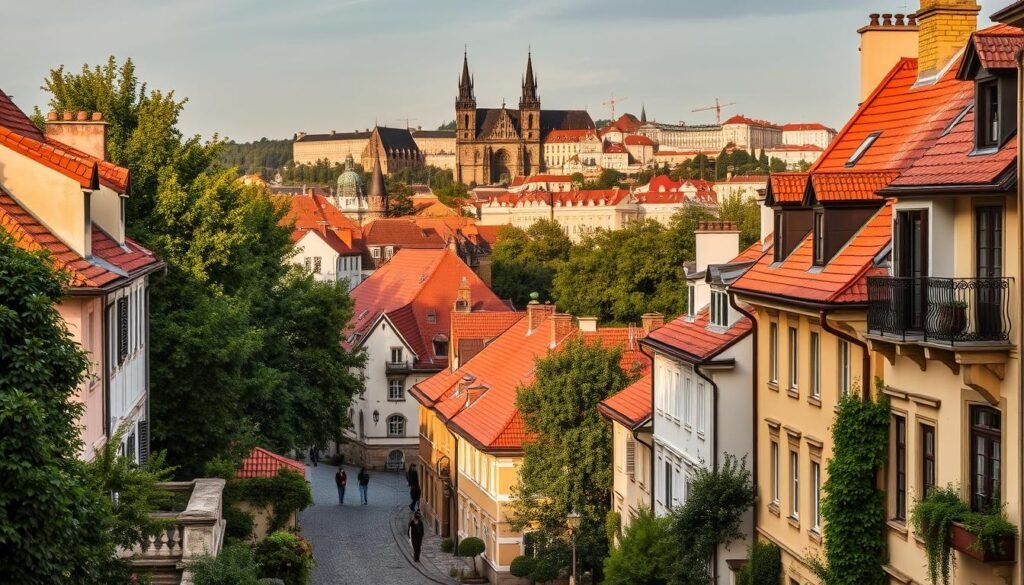
I slip across the bridge and immediately slow my pace in Malá Strana’s shaded lanes. Baroque facades and lantern-lit streets invite a mellow walk that contrasts with the busy center.
I climb the St. Nicholas Church bell tower for postcard rooftops and wide views. From the top I line up the castle with terracotta roofs and plan my shots for blue hour.things-to-do-in-kona/
Kampa Island and the Lennon Wall
I loop down to Kampa Island for river-level photos and then stop at the John Lennon Wall before tour groups arrive. Nearby gardens like Vrtba and Wallenstein offer calm corners and seasonal blooms.
- I find traditional pubs where a beer once cost around 29 CZK—great value without the tourist fuss.
- I follow tiny passageways and hidden courtyards that most visitors miss.
- I end with a gentle route back toward the castle or across the river, depending on energy and light.
| Spot | Why go | My quick tip |
|---|---|---|
| St. Nicholas bell tower | Postcard rooftops and castle alignment | Arrive before golden hour for clean light |
| Kampa Island | River-level photos and reflections | Walk the riverside at low wind for mirror images |
| John Lennon Wall | Colorful murals and street art | Visit early to avoid school groups |
| Vrtba & Wallenstein gardens | Quiet vistas and baroque plantings | Check seasonal opening times |
Jewish Quarter (Josefov): synagogues, history, and quiet corners

Stepping from old town into Josefov feels like turning a quieter page of the city’s history. I enter along calm streets where ornate facades and modest shops sit beside solemn courtyards.
I plan my visit around the Spanish Synagogue, the Old-New Synagogue, and the ancient cemetery. Arriving early helps me avoid the midday crowds and gives the monuments a still, reflective air.
The quarter survived much change, including demolition at the turn of the 20th century and the grim intent during WWII. That past is visible in the buildings and in plaques I stop to read.
- I loop back toward the town square with a coffee stop at a quiet corner.
- I follow simple respect rules: dress modestly and ask before photographing interiors.
- I point out small carvings and ironwork that often go unnoticed between major stops.
Josefov is compact, solemn, and full of detail. I fold it into my day’s route and let the calm here reset my pace for the rest of the city.best-time-to-visit-banff/
Iconic views: towers, hills, and the most epic city panoramas
![]()
I time my climbs so the city unwraps in soft light, layer by layer. Prime vantage points give you clear views of the river, prague castle, and the stitched rooftops that make this city feel small and grand at once.
Old Town Hall, Powder Tower, and Petřín
I start at Old Town Hall for a broad sweep and then loop to the Powder Tower. The Powder Tower offers a 50% first-hour discount, so I plan a morning loop that saves cash and crowds.
Petřín’s Lookout Tower feels intimate compared with the taller town tower. I usually ride the funicular up when I’m tired, or walk when I want the slow climb and photo stops.
Strahov library peek and a well-earned beer
I often glimpse Strahov’s famed shelves from the doorway if I missed the advance tour. Then I reward the climb with a local monastery brewery brew—quiet and delicious after a long walk.
Letná, Vyšehrad, and gear tips
Letná Park frames the best river bend with charles bridge and the castle aligned. Vyšehrad is my sunset escape for dramatic, crowd-free angles on the walls.
- One paid tower + two free hills balances budget and variety.
- Bring a 24–70mm lens, a light tripod, water, and sensible shoes.
“Mixing a paid tower, a hilltop park, and a monastery stop makes one unforgettable afternoon.”
Dancing House and modern Prague: quirky art, Kafka’s head, and Lucerna
![]()
Modern Prague flips the script on its medieval streets with playful architecture and kinetic sculptures. I start at the Dancing House, the 1996 collaboration by Vlado Milunić and Frank Gehry, for a fresh skyline angle and a rooftop bar view you can reach with a purchase.best-time-to-visit-seattle/
Rotating Franz Kafka head and the upside-down horse
I time my visit so David Černý’s 11m rotating Franz Kafka head is moving—its 42 layers create mesmerizing reflections that film well. I point out the best spot for slow-motion clips and where reflections read clearly against the water.
Nearby, Lucerna Passage holds Černý’s upside-down horse. It’s a great quick stop for a laugh and a reminder that modern art here teases the past, not replaces it.
Rooftops by paternoster and riverfront photo spots
I ride Lucerna’s paternoster up to a small rooftop and explain how to board confidently: step on quickly, hold the rail, and never block the lift. Then I map an easy riverfront walk along the Vltava River that lines up bridges and reflections, including a clear sight back to Charles Bridge.
- Quick loop: Dancing House rooftop, Kafka head, Lucerna paternoster, riverside photos.
- Photo challenge: capture lines, motion, and reflections in five frames today.
- Transit: nearby trams drop you close if your feet need a rest.
“Mixing medieval views with modern art adds a playful chapter to any city route.”
Things to do in Prague for food and beer lovers
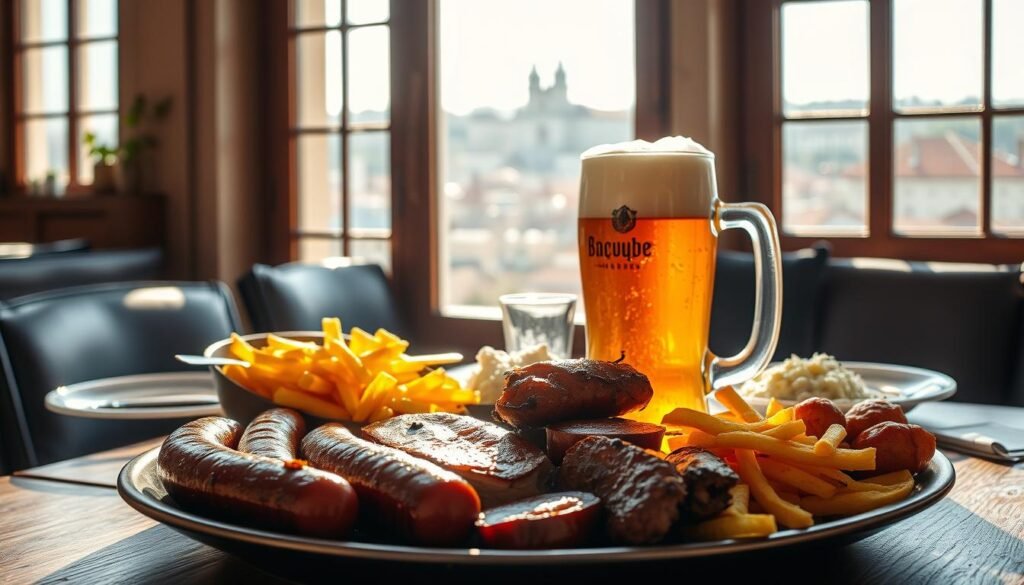
A great day here often starts with a bowl of garlic soup and ends with a pilsner at dusk. I map meals around quick routes so I spend less time waiting and more time tasting.
What I actually eat: I order svíčková (beef sirloin in a creamy root-veg sauce with bread dumplings), a hearty beef goulash, smažený sýr (fried cheese), and česnečka (garlic soup). Chlebíček open sandwiches make a perfect snack between sights.best-places-to-visit-in-colorado/
Beer like a local
Pilsner is the baseline. Locals joke beer can be cheaper than water, so I watch for tourist markups and use benchmark prices to judge value.
- I look for classic pours at Lokál-style beer halls for a true draft experience.
- Try řezané (half-dark, half-light) if you want a balanced sip.
- For a different night, I swap a garden for a beer spa session—relaxing and delightfully local.
Tour ideas and a tasting day
My low-effort plan: a lunchtime cruise on the water, an afternoon food tour, then an evening in a buzzing beer hall. For a deeper path, book a guided prague beer tour.
“Reserve Lokál or popular food tours in peak season; I book evenings a week ahead so I don’t miss my top picks.”
Easy day trips I love: Český Krumlov and Karlovy Vary
When I crave river-lined lanes or restorative springs, I leave the center for a day. Both towns sit within easy reach of the city and reward slow wandering.
Český Krumlov: castle views on the Vltava and staying overnight
Český Krumlov is a UNESCO-listed town on the Vltava River with the country’s second-largest castle after Prague Castle. I plan an overnight stay when I can; evenings quiet the streets and mornings give fairytale views above the water.
I weigh an organized tour against bus or train options based on my available time. If I only have a single day, a guided tour saves transit stress. If I can stay, I find the best photos down narrow lanes once day tourists leave.
Karlovy Vary: colonnades, hot springs, and spa sips
Karlovy Vary, founded by Charles IV in 1370, feels like a spa chapter of Czech history. I walk the elegant colonnades and sample mineral waters at public taps. A short self-guided route through thermal sites gives a calm, restorative pace.
- Pack light and wear comfortable shoes—both towns reward slow wandering and frequent photo stops.
- I sometimes add a beer spa or a small brewery visit when time allows.
- Quick rule: one overnight in Český Krumlov, a long day for Karlovy Vary unless you crave spa time.
“You’ll find quieter lanes and better light when you linger past the main tourist hours.”
How I get around Prague today: airport to city, trams, and tickets
Getting from Václav Havel Airport into the heart of the city sets the tone for every hour that follows. I take Bus 119 to Nádraží Veleslavín, then switch to Metro Line A (green). Door-to-door this usually takes about 35–50 minutes depending on luggage and transfer waits.
Bus 119, validation, and passes I use
Before boarding I validate my ticket. A 30-minute ticket runs ~24 CZK and a 90-minute ticket ~40 CZK. I buy tickets at machines, metro stations, or kiosks—today I grab one at the airport machine.
- When I pick a 1-day pass: on a castle-heavy day it saves time and fares (roughly 120 CZK for a day, 330 CZK for 3 days).
- Tram tips: trams 22 and 23 are my fast way up the hill toward the castle; I time connections to cut waiting.
- Walk vs. ride: short hops under 20 minutes I often walk; longer cross-river legs I ride.
Hour-by-hour note: morning trams get busy 7–9am; late afternoons tighten again. I pin stops on my offline map, keep coins or a card ready, use elevators and clear platform signs when I need accessibility, and watch my bag on busy routes.
“A small transit plan and validated ticket keep my trip smooth and on time.”
Where to stay: my favorite central picks across budgets
I match my hotel choice to the mood I want: calm nights or central hustle. Below are three bases I use depending on energy, group size, and how many views I want from my window.
Budget gem: Hotel Pod Vezi by the Charles Bridge
Hotel Pod Vezi sits at the base of Charles Bridge on the Lesser Town side. It feels upscale but stays affordable and has a guest rooftop terrace for quiet evening drinks.
Best for space: VN3 Terraces Suites by Adrez
VN3 offers modern apartments near Wenceslas Square. Studios and two-bedrooms work well for families or longer stays, and terraces make mornings feel private and bright.
Splurge with views: Four Seasons Hotel Prague
The Four Seasons fronts the river in Old Town. Request a river-view room facing Prague Castle and Charles Bridge; waking up to that panorama is worth the upgrade.
- How I pick: Old Town for first-timers, Lesser Town for calm nights and easy bridge access.
- Nearby places: local cafes, classic beer halls, and small bistros within a short walk from each hotel.
- Transport: all three link well to trams and metro—I plan morning departures based on my route.
“I usually book a two-night minimum so I can exhale between big sightseeing days.”
Best time to visit: spring, fall, and magical Christmas markets
I pick my travel windows by how light feels over the skyline and how crowded the streets look. Spring and fall give mild weather, blue skies, and shorter lines, making walking and photos much easier.
Beating summer crowds and why winter can be wonderful
Summer is busiest and hottest. I start at dawn, take a midday museum break, and use late-night strolls for empty squares and calm light.
Winter brings a fairytale night scene. Christmas markets fill Old Town Square and Wenceslas town square (Nov 29–Jan 6, 2026). Even cold snaps cut crowds and boost atmosphere.
| Season | Why I pick it | My quick tip |
|---|---|---|
| Spring | Warm days, light crowds | Book midweek rooms; golden-hour photos |
| Summer | Longest daylight, busiest | Early starts, museums at noon |
| Fall | Cool air, vivid light | Layer clothing; aim for weekdays |
| Winter | Markets, twinkling nights | Dress warm; split day between market and museum |
Packing notes: light layers for spring/fall, sun kit for summer, insulated coat and boots for winter. I lock rooms early for holiday dates and follow my go/no-go rule: skip peak heat if you hate crowds; embrace winter if you love mood and markets.
Conclusion
I close most trips with a quiet loop that links castle lights, a beer, and a skyline.
I recap here: weave major sights into a paced route across the compact city. Pick a short list that matches your style—early photos, tower climbs, beer halls, or quiet corners—and follow that way for calm progress.
My end-of-day place is a low-lit riverside bench near the bridge. I sit, sip, and watch rooftops warm as lights come on. That pause turns a busy day into a neat memory.
Quick reminders: check opening times and buy key tickets ahead. Add one day trip outside the center if you can; Český Krumlov or Karlovy Vary extend the trip nicely.
I hope this guide helps you plan a smooth visit and see the things prague does best—history, flavor, and endless views—your way.


